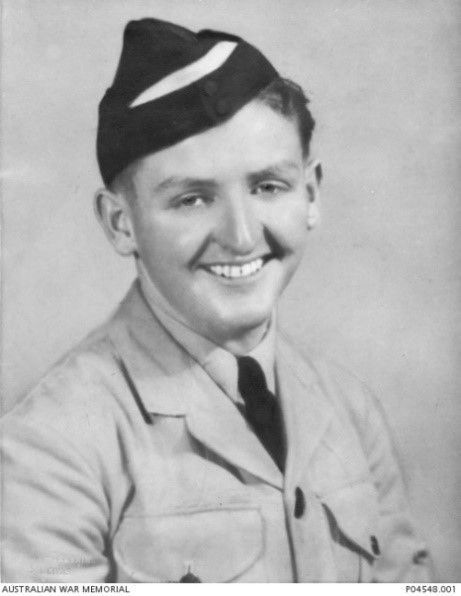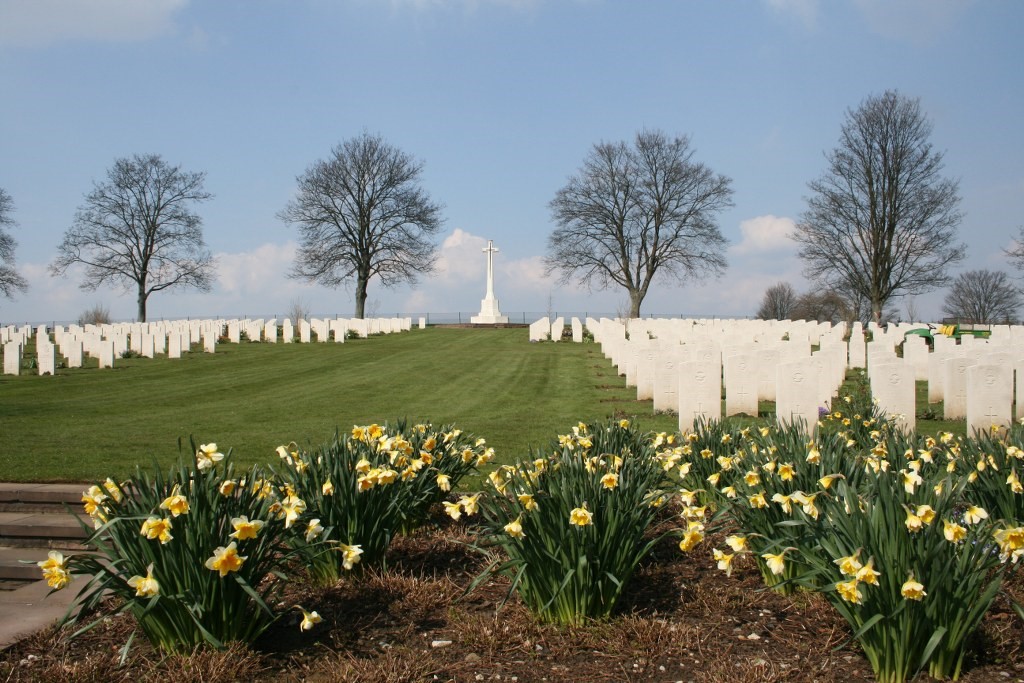Flight Sergeant Neil McGladrigan, the son of William Patrick McGladrigan and Doris Vida May McGladrigan (nee Quick) was born at Brisbane in Queensland on 8th December 1922. His father was the Headmaster of a number of primary schools throughout Queensland including the Rangeville State School. He was educated at the Milora State School during 1935 and he then attended the Nudgee College during the years 1936 until 1939. He then attended the Toowoomba Grammar School during 1940 and passed the University of Queensland Senior Public Examination. After leaving school he began studies at the Teachers’ Training College in March 1941. He applied for aircrew training in the Royal Australian Air Force on 19th December 1941.
Flight Sergeant Neil McGladrigan was enrolled in the Reserve of the R.A.A.F. on 15th January 1942 after swearing the statutory oath of allegiance. He was issued Reserve Badge No. 5790. At the age of 19 years and 7 months he was enlisted into the Citizen Air Force of the R.A.A.F. at No. 3 Recruiting Centre in Brisbane on 15th August 1942 after giving a commitment that he would serve for the duration of the war and an additional twelve months. He was allotted the service number of 426895. At the time of enlistment he was unmarried, a Student Teacher and residing at the Rangeville State School in Toowoomba. His physical description was that he was 5 feet 5 inches in height and weighed 122 pounds. He had a medium complexion, grey eyes and brown hair. He stated that he was of the Roman Catholic religion. He gave his next of kin as his father, residing at the State School at Kallangur in Brisbane.
Flight Sergeant Neil McGladrigan joined No. 3 Initial Training School at Sandgate in Queensland on 15th August 1942 where he was trained in the basics of service life and aviation. He joined No. 1 Air Gunnery School at Cootamundra in New South Wales on 10th December 1942 as a student on No. 33 Gunnery Course. He then joined No. 1 Bombing & Gunnery School at Evans Head in New South Wales on 8th March 1943. After completing his course at Evans Head he joined No. 1 Air Navigation School at Parkes in New South Wales on 31st May 1943 as a student on No. 32 Air Observer Course. He was awarded the Navigator Qualification Badge on 21st May 1943 and promoted to the rank of Temporary Sergeant on 24th June 1943 He joined No. 3 Embarkation Depot at Sandgate in Queensland on 4th July 1943 to finalize his personal affairs and farewell his family in preparation for service overseas. He embarked for overseas service on attachment to the Royal Canadian Air Force from the port of Brisbane in Queensland on 6th July 1943.
Flight Sergeant Neil McGladrigan disembarked in Canada on 25th July 1943 and later that day joined No. 3 Manning Depot at Edmonton. He joined No. 1 General Reconnaissance School at Summerside on 4th September 1943. After completing training he embarked from Canada on 1st November 1943. He disembarked in England on 9th November 1943 and joined No. 11 Personnel Despatch and Reception Centre at Brighton. He was promoted to the rank of Temporary Flight Sergeant on 24th December 1943. He was at Royal Air Force Station Hednesford during the period 17th January until 17th March 1944. He joined No. 6 (Observer) Advanced Flying Unit on 21st March 1944. He then joined No. 17 Operational Training Unit at Royal Air Force Station Silverstone on 18th April 1944. He attended the Aircrew School at 51 Base at Royal Air Force Station Winthorpe during the period 12th July until 25th July 1944. He trained with No. 1661 Heavy Conversion Unit at the base during the period 25th July until 7th September 1944 where he received training for night bombing. He joined No. 57 Squadron at Royal Air Force Station East Kirby for operational duties on 20th September 1944.
Flight Sergeant Neil McGladrigan was the Navigator (Air Bomber) and crew member of a No. 57 Squadron Royal Air Force Lancaster that left Royal Air Force Station East Kirkby in Lincolnshire at 16.55 hours on air operations on 6th December 1944. The aircraft was detailed to attack an enemy target at Hessen, Germany. The aircraft failed to return to its base. It was subsequently found that the Lancaster had been shot down at Erdhausen on 20.15 hours by night fighters.
On 7th December 1944 the Officer Commanding No. 57 Squadron wrote the following letter to his father:
Dear Mr McGladrigan, It is with profound regret that I write to confirm the cable you will have received informing you that your son, Flight Sergeant Neil Francis Dellaway McGladrigan, is missing following operations on the night of the 6th December 1944. He was the Air Bomber of an aircraft detailed to take part in a raid against a target in Germany, but as it is customary to maintain radio silence after take-off, it has not been possible to determine the cause of its failure to return. Your son had made many sorties with the Squadron and I had formed a very high opinion of his capabilities. It was my earnest hope that he would have completed a successful tour of operations here. I know that Captain, Flying Officer W. Riddell, would have done everything in his power to ensure the safety of his crew and there is of course, every possibility that they were able to abandon the aircraft and land safely in enemy territory. We all sincerely hope that this will prove to be the case, in which event news will ultimately reach you through the International Red Cross Committee. We can only hope and pray that they are safe and I wish to extend to you my own personal sympathy and that of all members of my Squadron during the anxious time you have waiting for news. Any further official information concerning the missing aircraft or crew will be sent to you by the Air Ministry, but if, as sometimes happens, you receive news from outside sources, I shall be most grateful if you will let me know.
The following report appeared in the Queensland Times newspaper on Saturday 24th November 1945:
FORMER MILORA BOY PRESUMED DEAD. Advice has just been received from the Air Board by Mr W.F. McGladrigan, Head Teacher, State School, Kallangur, to the effect that his elder son, Flight Sergeant Neil Francis McoGladrigan, who was reported missing on December 6, 1944, from bombing operations over Guissen, Germany, has now been presumed dead. The late Neil McGladrigan spent his early boyhood days at Milora, gaining his scholarship under his father who was then Head Teacher of the Milora School. His secondary education was gained at Nudgee College and later at Toowoomba Grammar School, from which he matriculated to the University. Prior to enlisting he was on the staff of the Toowoomba East State School, and was 21 years of age at the time he was posted missing.
On 4th March 1945, R.A.A.F. Headquarters received information from the International Red Cross Committee in Geneva that Flight Sergeant McGladrigan and Flight Sergeant Black had been captured and that the remaining 5 crew members had lost their lives. On 28th March 1946 the Secretary of the Department of Air in Melbourne was informed by the Judge Advocate General that Flight Sergeant Neil McGladrigan was murdered three days after he was captured. Karl Menger, Karl Schmidt, Konrad Mangold, Ludwig Will and Otto Koch were accused of the murder. The above with the exception of Menger were being held in custody at the civilian prison at Marburg-Lahn, Hessen, in the American Zone of Germany, and instructions had been issued for the convening of a Court to try the accused. Details of the burial place of Flight Sergeant McGladrigan had not been received and a letter was sent to the Judge Advocate General’s Department with a view to obtaining that information. (Pages 49-52 of Neil McGladrigan’s Casualty/Repatriation File give the chilling details of his murder by the accused).
Further information from the Judge Advocate General’s Department was received to the effect that Neil McGladrigan was shot and killed on or about 10th December 1944 in a spot in the woods bordering on the road leading from Runzhausen to Gladenbach, Kreis Biedenkopf, Hessen Germany, and that he was buried at the spot where he was murdered. His remains were later exhumed and positively identified by a United States pathologist who found an Observer badge, flight sergeant chevrons and his rank, name and number (426895) on the body’s underpants. The American Army of Occupation reburied his remains in the German Cemetery at Gladenbach. His remains were subsequently concentrated into the Hannover War Cemetery in Germany on 11th June 1947. Because he had been denied a Christian burial he was buried with a religious ceremony conducted by the Reverend Father Taggart a Roman Catholic Chaplain. He rests alongside two other airmen who were also murdered by Germans.
Flight Sergeant Neil McGladrigan at the time of his death was 22 years of age. For his service during World War 2 he had entitlement for the Air Observer Qualification Badge, the 1939/1945 Star, the Aircrew Europe Star, the Defence Medal, the War Medal and the Australian Service Medal 1939/1945. His name is commemorated on Panel No. 126 at the Australian War Memorial in Canberra and locally on the Toowoomba Grammar School World War 2 Honour Board.
Mangold, the German who murdered both McGladrigan and another airman, was sentenced to death by shooting. Ludwig Will who was concerned with the shooting was sentenced to ten years imprisonment. Schmidt who instructed Will to dig the grave in which Neil McGladrigan was buried was found guilty of complicity in the crime and sentenced to one year of imprisonment. Koch who was present at the murder under protest and who handed over McGladrigan to Mangold under protest was found not guilty.
It is of interest that when the American Graves Registration Unit exhumed the body of Sergeant Scott who was buried near Weidenhausen the Americans assembled all the local ex-Nazi Party members on the occasion and made the Burgomeister, Herr Scheld, give a speech. The following is an extract of the speech:
This body is a stigma for the German respect all over the world. The persons responsible for it are now standing before us. That means that we not only know who is really responsible for committing the crime itself, but we know also the true authors for such crimes who will have to be made responsible for the cause of the crime. These are your beloved Fuehrer and all propagandists such as Goebbels and Hans Fritzsche. As many of you know, Himmler used to give his orders verbally. In case some of you tell me now, that they acted only according to orders they received, I say to you, that nobody can force me to execute an order which is against my feelings and honour. Being a decent and civilized creature, I can by no means agree with an order which demands committing a crime. In this case – unfortunately there are already two cases here now – not only the perpetrator will be regarded with horror and indignation but the whole nation may be judged by the action of those two.
Where do you think it would lead, if all over the world such methods were the principles of conducting war? In 1940/41, when the German Luftwaffe flew attacks over England, many mothers and brides were informed that their sons and fiances had not come back. But this did not yet mean, that the airman was dead and they all wished and hoped he had been able to bail out and be safe as a well-treated prisoner of war. Why did they feel that way? Because everybody expected the Allies to treat their prisoners of war decently. Why should the brides and mothers of English airmen have less right to hope for a safe return of their menfolk?
Flight Sergeant Neil McGladrigan’s temporary cross (with incorrect initials and date of death) in the Hanover War Cemetery prior to its development by the Imperial War Graves Commission and placement of uniform headstones. The official headstone later placed above his grave in the cemetery carries the family inscription “Dearly loved and sadly missed by Dad, Mum and brother Bob”. The Hanover War Cemetery contains 2,407 Commonwealth burials of the Second World War, 62 of them unidentified. His body rests beside Sergeant Scott who was also murdered.
Note
Flight Sergeant Neil McGladrigan’s brother Flight Sergeant Robert Hugh McGladrigan (434261) also served overseas on attachment to the Royal Air Force.
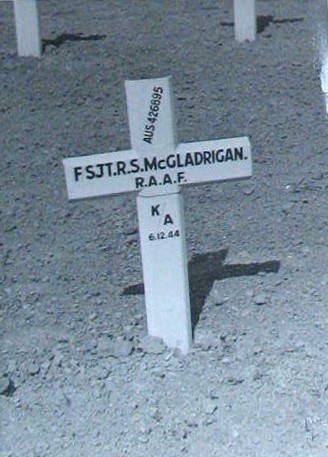
A temporary cross erected over Neil McGladrigan’s grave after his remains were interred in Hanover War Cemetery.
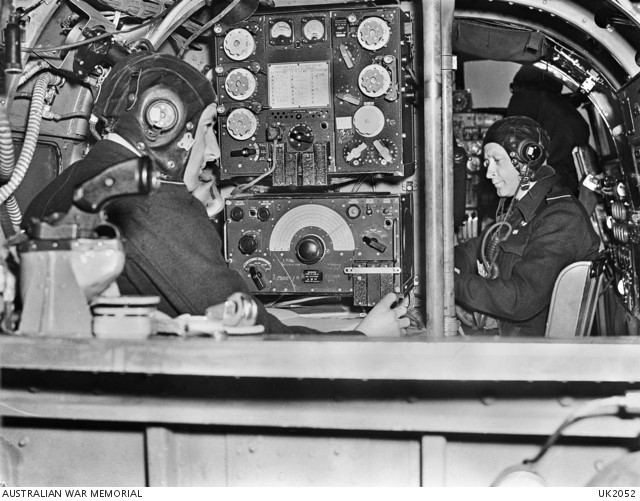
Australian War Memorial photograph UK2052
A Wireless Operator (left) tuning his radio and a Navigator (right) at his table in “G for George” a Lancaster aircraft of No. 460 Squadron.
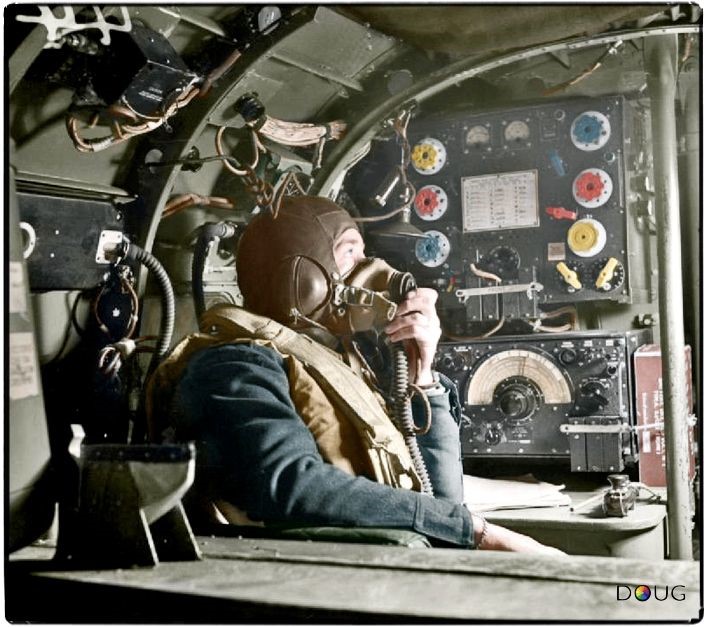
A Wireless Operator in a Lancaster speaking to the pilot from his position in front of the Marconi Transmitter/Receiver set.
Toowoomba Grammar School archive records show that he enrolled as a day student. His parent was shown as Mr William P. McGladrigan, Head Teacher, Rangeville State School. He completed senior at Toowoomba Grammar School after attending Nudgee College till his father’s transfer to Rangeville. He entered Teachers’ College in 1942.


